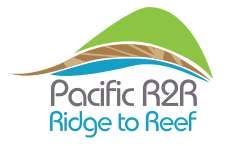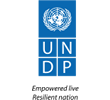
Description/achievement of initiative
The goal of the Pacific Islands National Priorities Multi-Focal Area ‘Ridge-to-Reef’ (R2R) program is to maintain and enhance Pacific Island countries’ ecosystem goods and services (provisioning, regulating, supporting and cultural) through integrated approaches to land, water, forest, biodiversity and coastal resource management that contribute to poverty reduction, sustainable livelihoods and climate resilience. This goal will be achieved through a series of national multi-focal area R2R demonstration projects which will support and address national priorities and development needs while delivering global environmental benefits in line with GEF focal area strategies (Biodiversity, Land Degradation, Climate Change Mitigation, International Waters) and Climate Change Adaptation. In this programme, the Pacific Islands Countries (PICs) emphasize the need to focus on their own priority national activities as they utilize STAR resources. Experience has shown that an integrated approach from ridge to reef (and ocean-Ridge to Reef or R2R) is necessary for poverty reduction, sustainability, and capacity enhancement for small countries with few human resources to undertake projects. Hence, each country is planning to adopt specific aspects of R2R (see Section E for details).
Implementation methodologies
The Pacific Islands R2R program has been designed by the Pacific Island countries to strategically use their GEF STAR allocations to meet both their national priorities and adhere to relevant GEF focal area objectives, outcomes, indicators and outputs. Other than Papua New Guinea and Fiji, all the Pacific Island countries have STAR allocations less than $7 million which allows them flexibility to program all of their STAR resources across individual or multiple focal areas and focal area strategies. Using this flexibility, each national R2R project (PIF) is being designed to deliver tangible and quantifiable global environmental benefits across one or more GEF STAR focal areas, strategies, and funds, including consistency with BD, LD, CC-M, CC-A (SCCF) and IW focal areas as well as SFM. The R2R approach provides the appropriate framework for multi-focal projects addressing environmental and natural resource management issues in priority catchments and their linked coastal areas. Actions in each focal area are intended to complement each other to promote a truly integrated approach in managing biological diversity and other natural resources. The program seeks to focus on innovation, testing, and catalyzing implementation of cutting-edge methodologies, technologies and policy reforms with the objective of enabling replication and future scaling-up of integrated R2R approaches.
Arrangements for Capacity-Building and Technology Transfer
National and local capacities for ICM, IWRM, SLM and SFM will be improved to enable best practice in integrated, climate resilient Ridge-to-Reef approaches in natural resource management. This will be accomplished through:-National training needs assessments to identify priority needs and for the development of formally accredited courses for the effective transfer of knowledge and skills in integrated approaches in environment and natural resources management;Advanced training in ICM/IWRM and other integrated (SLM, SFM) approaches to natural resources and environmental management and climate change adaptation conducted to benefit government staff in all PICs in collaboration with internationally-recognized institution(s) for the conduct of the training and use of training toolsNational human capacity strategies for mainstreaming R2R (ICM, IWRM, SLM, SFM) will be formulated and adopted in 14 PICs to accompany innovative post-graduate training program and mentoring/leadership programs.GEF funding is directly focused on developing demonstration sites with the latest, but small-scale, technology that will be appropriate for Pacific island communities by promoting the use of appropriate technology, traditional knowledge and practices and strengthen linkages with nationally available expertise and through the development of key knowledge tools in the form of synthesis reports on: (i) climate variability in coastal systems; (ii) hazards and coastal area planning; (iii) ‘blue forests’ and livelihoods; (iv) spatial planning in coastal fisheries; (v) water security and wastewater management; and (vi) land and marine tenure and use designation, including implications for coastal and marine spatial planning. These will be disseminated online and supporting multi-media products will be developed and syndicated regionally to stimulate national and regional level uptake and use in policy-making and planning. To further support the uptake of regionally accumulated scientific knowledge in policy-making and planning, the project will facilitate exchanges between government and the scientific community via meetings of the Regional Steering Committee and national Inter-Ministry Committees. Linkages will also be established with the community leaders and local government round-table meetings to support broad dissemination of regionally consolidated knowledge and science at the community level.
Coordination mechanisms/governance structure
The R2R program as a whole will be guided by an R2R Program Steering Committee (PSC) which will meet annually to review progress, provide strategic guidance and advice, and facilitate program level coordination and communication. The R2R Regional Steering PSC the national inter-ministerial committee) the GEF agencies (UNDP, UNEP, FAO) and the Pacific Community (SPC). Regional and National Program Coordination mechanisms have been put in place to ensure National, regional and Inter agency coordination of the program’s supporting projects. National inter-ministerial committees provide oversight of integrated approaches and national reporting whilst regional technical and operational backstopping support is provided to national R2R projects to facilitate timely delivery of overall program goals. The regional project will also provide coordination functions and linkages with the GEF biodiversity, climate change, land degradation, Forests and International Waters focal areas in the national STAR projects and would facilitate dialogue and action planning through national Inter-Ministry Committees on responses to emerging water, land and climate issues. Similarly it will facilitate coordinated exchanges of experience and results of the GEF portfolio of investments in a broader regional R2R programme for PacSIDS. Linkages with co-financed activities on water resource and wastewater management, coastal systems and climate adaptation and disaster risk management will ensure more targeted capital investment in coastal infrastructure within an ICM framework.
Partner(s)
Cook Islands, Fiji, Micronesia, Kiribati, Marshall Islands, Nauru, Niue, Papua New Guinea, Palau, Solomon Islands, Tonga, Tuvalu, Vanuatu, and Samoa with the GEF, UNDP, FAO, UNEP and SPC.
Full Story: https://sustainabledevelopment.un.org/partnership/?p=7315





